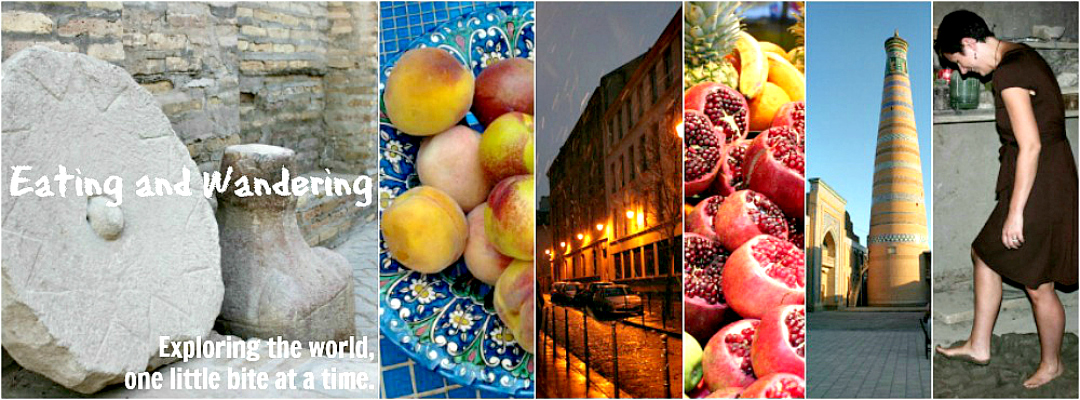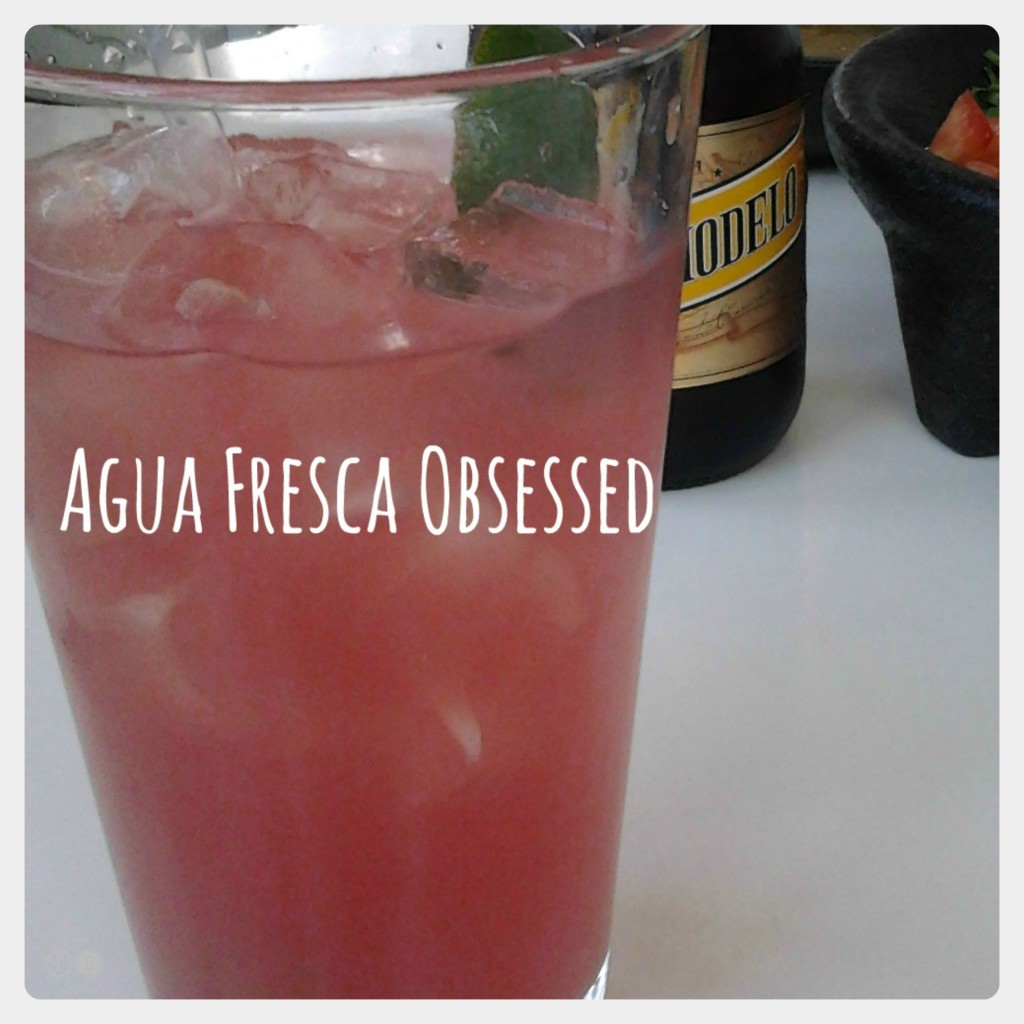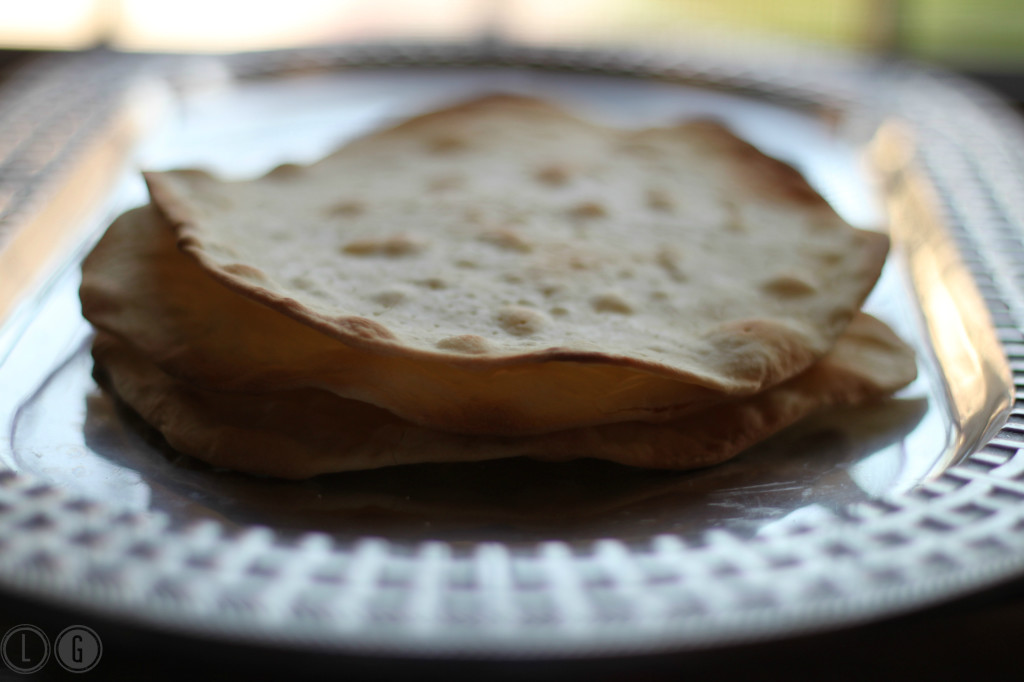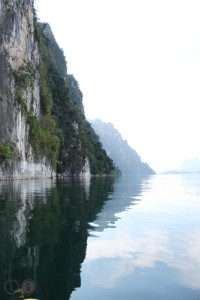Spring is upon us here in Uzbekistan. The spring holiday Navruz (which translates to New Day) is nearly here, coming with the equinox. Next Monday Passover will be here, and then Easter. Spring is definitely springing!
For us, the arrival of Passover always means shifting the way we eat. It’s not just about forgoing bread and other leavened products, but it’s also about exchanging the heavier comfort foods of autumn and winter for the fresh, crisp spring produce appearing in the markets.
I started my seasonal change of eating last week, after our return from three weeks abroad. For me travel is never a time for dieting, and we ate very well everywhere we went. So well that I was feeling a bit overfull and sluggish once we returned, and I decided it was time to think about some fresh, healthy, and interesting meals.
One of the best meals we had on our trip was a late weekday breakfast at Ottolenghi, the brainchild of chef Yotam Ottolenghi. On our previous trips to London we’d missed going to the sitdown restaurant of this small local chain, despite the exhortations of our friend Linda and her daughter. They are both vegetarian, and while Ottolenghi has its fair share of meat on the menu, the chef’s creativity is really on show with the vegetarian dishes.
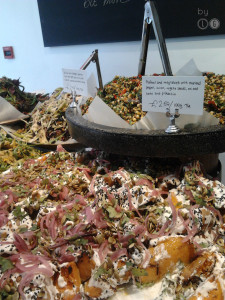
An array of salads at Ottolenghi.
We made it in just in time to still catch breakfast late on a Tuesday morning, and I spied my dish immediately: shakshuka. I could write reams about my adoration of shakshuka, which I first had deep in the Negev some seven or eight years ago. Shakshuka is an egg dish cooked over a slightly spicy tomato and pepper sauce. If you’ve ever had menemen in Turkey it’s very similar, but the eggs are sunny side up rather than scrambled into the sauce.
My dish arrived in the copper pan in which it had been cooked, and nestled on top of my eggs was a creamy dollop of labneh, the cheese made by straining the whey from yogurt. In Uzbekistan there is a very similar food known as suzma made from the strained local yogurt (which translates as “sour milk,” but it’s really quite delicious). I am never one to turn down cheese, or nearly any dairy product for that matter, and as I scooped my eggs and tomato sauce onto the generous slabs of toast, I added a little schmear of labneh, too. It was heavenly. Before we departed Ottolenghi we loaded up on goodies for our plane trip home that night, including a couple of vegetable salads and a little plum cake.
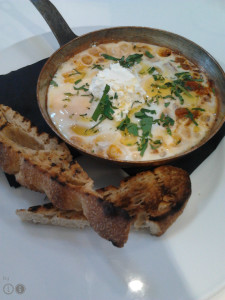
Delicious breakfast shakshuka. With labneh!
That meal was the perfect punctuation to our trip, and the perfect transition into spring. We came home to temps in the 70s, but were met with a snowstorm the next day. Ah, spring! But despite the snow my memories of all those crazy salads stuck with me, and I started hatching a plan. Now each week I’m making an interesting salad that goes beyond the basics. Last week I made black bean and corn salad (not the most unusual, but it took a little creativity!), and this week I made a salad with chickpeas, carrots, cucumber, red pepper, and fragrant cumin-scented dressing. I’m actually a little bit excited about lunch today!
Since my reacquaintance with labneh/suzma, I’ve been buying out the plain yogurt at our local store. Every day last week, in addition to my spicy salad, I brought a little serving of homemade suzma dressed with a drizzle of olive oil and some za’atar spice and enjoyed it with a couple slices of the local black bread, tomatoes, and cucumbers. My delicious lunch drew interest, and I gave a little lesson on the making of labneh/suzma with local products.
I’m quite looking forward to the next couple of weeks when all the spring produce will start flooding the local bazars and meal prep will become ever more interesting!
Try Ottolenghi’s divine-looking recipe for labneh with olives and pistachios, via The Guardian. I don’t have access to goat’s yogurt, so I just use plain yogurt. I also strain my yogurt in the refrigerator–haven’t gotten brave enough to leave it out and straining for a full day.
16 oz. goat’s yogurt
16 oz. natural yogurt
Coarse sea salt
20 black olives, pitted
1½ tbsp roughly chopped fresh oregano
1 tbsp chopped parsley
Grated zest of 2 lemons
1 small garlic clove, crushed
1/3 cup olive oil
3/4 oz. pistachios, lightly toasted
3/4 oz. pine nuts, lightly toasted
½ tsp flaked chilli
3 ripe tomatoes
½ a small red onion, thinly sliced
Line a deep bowl with cheesecloth or muslin. In another bowl, stir the two yogurts and half a teaspoon of salt, pour into the cloth, bring together the edges to form a tight bundle and tie securely with string. Hang the bundle over a bowl, or over the kitchen sink from the tap, and leave for 24-36 hours. After this time, much of the liquid should have drained out and the remaining yogurt will turn thick and quite dry; the centre may still be creamy.
Remove the labneh from the cloth and transfer to a serving platter. Spread it over the plate with the back of a spoon, creating a loose, wavy pattern about 2cm thick.
Next, roughly chop the olives and put them in a bowl with the oregano, parsley, lemon zest, garlic and olive oil (reserving two tablespoons of the oil for the tomatoes). Use a pestle and mortar to crush the nuts roughly, leaving some just broken and others finely crushed. Stir into the olive mix, then spoon this over the labneh, leaving a border of about 2cm around the edge (if you want your labneh a bit milder, don’t use the whole quantity), then sprinkle with chilli.
Finally, cut the tomatoes into thick wedges and mix with the sliced onion. Arrange on a side plate next to the labneh, sprinkle with salt and drizzle with the reserved olive oil. Serve the labneh and tomatoes with torn chunks of bread.
What about you? Do you change your eating and cooking with the seasons? Where do you draw inspiration?
